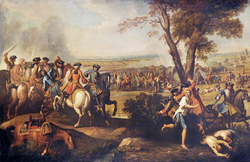People’s War: Difference between revisions
No edit summary |
|||
| Line 116: | Line 116: | ||
===Trinity Massacre=== | ===Trinity Massacre=== | ||
===Outbreak of War | ===Outbreak of War=== | ||
=Southern and Western Theater= | =Southern and Western Theater= | ||
Revision as of 03:22, 26 March 2020
| People's War | |||||||
|---|---|---|---|---|---|---|---|
| |||||||
| Belligerents | |||||||
|
Template:Country data Salvian Royal Family Supported by:
|
Supported by: | ||||||
| Commanders and leaders | |||||||
|
|
| ||||||
| Strength | |||||||
|
150,000 infatry 50,000 Loyalist militiamen 13,000 cavalry |
30,000 Royal Marines 250,000 militiamen 5,000 cavalry | ||||||
| Casualties and losses | |||||||
|
Total dead 55,000 Total wounded: 87,000 |
Total dead: 73,000 Total wounded: 95,000 | ||||||
| |||||||
The People's War (Aroman: Le Bello de Populi) was a 2-year civil war between democratic and monarchial forces in the Marenesian nation of the Sanctum Imperium Catholicum. Beginning on November 29th, 1707, it began after the firing on a federal fort off the coast of St. Paul’s by democratic forces, responding to many grievances committed by the monarch of the time, Peter III. It ended in a democratic victory, with the del Monte dynasty being overthrown and the institution of a new Constitution, forming the modern government type of Salvia
Overview
During the reign of Peter the Third, the relationship between the crown and the Concilio Populi severely deteriorated. Much of the bickering between king and parliament was over the native insurrection in Catholic Aslonia known as Peter’s War, which began in 1703. The war was incredibly unpopular due to the taxes that were levied by the king, which were targeted at the upper and middle classes. Peter eventually dissolved the Concilio in 1707 as they began to draft a peace deal with the native insurrectionists. When protesters in Trinity refused to disperse, soldiers fired upon the crowd, sparking unrest. The peaceful protests quickly turned violent; riots soon engulfed many cities, forcing Peter to invoke martial law. In the south of the country, parliamentarians raised a republican army from popular militias already forming. With tension between the two sides rising, Peter III would only worsen them and eventually start war with the Fort Leo Decree, so called because it was officially written by the king while visiting state forces in Fort Leo. The decree angered republicans and would lead to the bombarding of Fort Leo on November 29th, 1707, signaling the start of the war.
Though they outnumbered the Royal armed forces, which had largely remained loyal to the crown except for the Royal Marines, their poor training and discipline on the battlefield dragged out the People’s War for another two years. The fighting was largely contained to the southern coast and islands, but Peter’s dwindling support in the northeast meant it soon reached his own throne in Deopolis. After a series of disastrous defeats, the remnants of Peter’s forces on the mainland were besieged in the capital. On 9 July 1709, Peter and his family, along with most of the royal court and kingdom’s nobility, set sail from Deopolis to Ristua, Eulycea. Three days later, monarchist forces in the city surrendered and signed (though only on their own behalf) the Treaty of Trinity, effectively ending the People’s War in a republican victory.
Grievances, Trinity Massacre, and Outbreak of War
Leadup to the Trinity Massacre
By the summer of 1706, Peter's War in the colony of Catholic Aslonia had become incredibly unpopular among most of the Salvian populace. To fund the war, Peter III had levied heavy taxes on land and trade which angered much of the upper and middle class. In an attempt to regain support, Peter introduced several laws that granted nobles, especially in the agrarian south, greater control over wages and living conditions for their laborers, and also cut back taxes on the wealthy and reintroduced new taxes on the urban working class and middle class. While appeasing the upper class, Peter further angered the middle and lower classes. The Salvian Catholic Church, under the leadership of Pope Pius IV, at first supported Peter III but was soon turned against him as he applied taxes on Church property.
The Concilio Populi, controlled by much of the middle class, and the Concilio Clerici which was controlled by Church clergy members, both began drafting peace deals for the rebels in Catholic Aslonia in early 1707 to end the war. After discovering this, Peter III illegally evoked the powers of the Concilios and dissolved them with military force on 3 March 1707. Protests immediately erupted across northern Salvia and St. Paul's island as the war in Catholic Aslonia continued. Tensions were further fueled when leaders of protests on St. Paul's island were executed for treason. In retaliation, conspirators planned for the assassination of the Minister of War, but were caught and executed.
Trinity Massacre
Outbreak of War
Southern and Western Theater
Northern Campaign
Monarchic Surrender and Aftermath
This template may be deleted.
